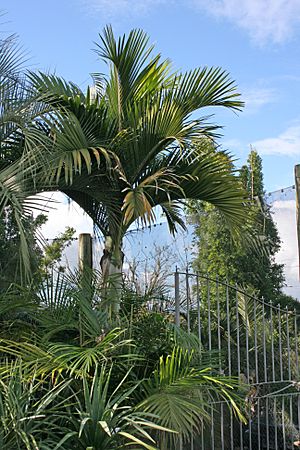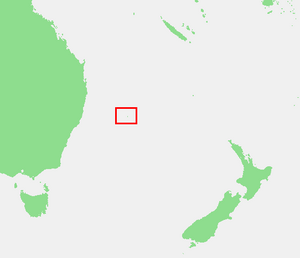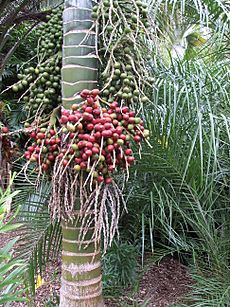Big mountain palm facts for kids
Quick facts for kids Big mountain palm |
|
|---|---|
 |
|
| Conservation status | |
| Scientific classification | |
| Genus: |
Hedyscepe
|
| Species: |
canterburyana
|
 |
|
| H. canterburyana is endemic to Lord Howe Island | |
The Hedyscepe canterburyana, also known as the big mountain palm or umbrella palm, is a special type of palm tree. It is the only species in its group, called Hedyscepe. This palm belongs to the large Arecaceae family.
This unique palm only grows on Lord Howe Island, which is part of Australia. Sadly, it is currently at risk because its natural home is being destroyed. The big mountain palm grows by itself, meaning it doesn't grow in clumps. It has a clear "crownshaft" (a smooth, often colorful part of the trunk below the leaves). It also has flowers that are either male or female.
This palm is related to the Rhopalostylis palms found on Norfolk Island and in New Zealand. Together, they form a smaller group of palms called Rhopalostylidinae. The Hedyscepe palm is a bit different from Rhopalostylis because its flowers have more than six stamens (the parts that produce pollen). Also, its male flowers mature before its female flowers.
What is the Big Mountain Palm?
The Hedyscepe canterburyana is a palm that grows slowly. It can reach up to 10 meters (about 33 feet) tall. You can find it in mountain forests, on cliffs, and on windy ridges near the sea. It usually grows at heights between 400 and 750 meters (about 1,300 to 2,460 feet) above sea level.
This palm has a thin trunk with rings around it. It also has a shiny, silver-colored crownshaft. The top of the palm has a compact group of dark green leaves, called fronds. These fronds are stiff and curve downwards, looking a bit like the leaves of another palm called Howea belmoreana.
The fruit of this palm is shaped like an egg. When it's ripe, it turns a deep red color and is about 4 centimeters (about 1.5 inches) long. These fruits grow in tight bunches below the crownshaft. Each fruit holds just one seed inside.
How to Grow the Umbrella Palm
Lord Howe Island, where this palm comes from, has a subtropical climate. This means it has mild to warm summers with regular rain. Winters are wetter and a bit cooler. In winter, the highest temperatures are usually between 17 and 20 degrees Celsius (63-68°F). In summer, they are between 24 and 27 degrees Celsius (75-81°F). The lowest temperatures in winter are about 12 to 15 degrees Celsius (54-59°F). In summer, they are about 18 to 22 degrees Celsius (64-72°F). The air is usually quite humid all year round.
Because of its beautiful arching leaves, the H. canterburyana is a very popular palm for gardens. People who love plants in cool subtropical and warm temperate areas enjoy growing it. It can be hard to grow in very hot places or where nights are never cool. However, it grows well in climates like Sydney and Auckland. Once it is established, it can even handle a little bit of frost now and then.
This palm needs rich soil with lots of organic material. For at least its first five years, it also needs some shade from the sun. It can grow well in pots or as an indoor plant if it gets enough light. Even a single palm can produce seeds that can grow new plants.
Fresh seeds can take a long time to sprout, and they don't always sprout at the same time. Seedlings might appear anywhere from five to 18 months after the seeds are planted. The fruit itself takes up to four years to become ripe. It can be tricky to know exactly when the seeds inside are ready.
See also
 In Spanish: Hedyscepe para niños
In Spanish: Hedyscepe para niños



